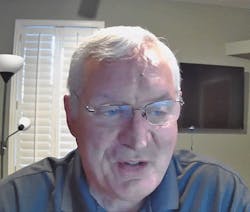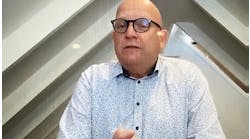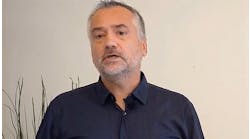Schneider Electric spearheads drive to universal, open automation
"Orchestration is about how to remotely support components in an O-PAS system, and how to make sure hardware from different vendors can occupy the same spaces." Schneider Electric’s Trevor Cusworth, together with Ananth Antony and John Conway, updated users on OPAF, IEC 61499 and the company’s Universal Automation offering at this week’s Innovation Talks.
Truly open, interoperable automation and control is the long-sought holy grail and much-desired Aladdin's lamp of the process industries. And now, its many potential benefits are tantalizingly within reach.
This promise of real interoperability is thanks largely to the courageous efforts of the Open Process Automation Forum (OPAF), which has Schneider Electric as one if its founding members and leaders.
"We've been an OPAF member since 2016 and heavily involved in the development of its Open Process Automation Standard (O-PAS), which is a 'standard of standards' that's increasingly integrating and complying with IEC 61499," said Trevor Cusworth, strategic account manager at Schneider Electric and co-chair of OPAF, who was referring to the international standard for using software function blocks to represent process measurements and control system functions.
"We now have 110 members, including end users, system integrators, suppliers and information technology (IT) companies. This is an operations technology (OT) and IT exercise, and we're still looking for more members to join."
Recent OPAF and IEC 61499 developments were detailed by Cusworth and two other Schneider Electric experts, who presented "Understanding the progress of OPAF and the rapid advancement of open process automation standards” at this week’s Schneider Electric Innovation Talks for users of company’s EcoStruxure Foxboro process automation systems and EcoStruxure Triconex safety systems.
Organize to realize the vision
The overall OPAF vision is for an open, secure, interoperable process control architecture that provides interoperable components, portable software and commercial availability; serves multiple industry sectors; protects suppliers' intellectual property; and expands markets for products and services from suppliers and system integrators. So far, OPAF released O-PAS, Version 1, defining interoperability requirements, in 2019; Version 2, on configuration portability, in 2020; and Version 2.1, on control functionality, earlier this year. Version 3, on application portability, orchestration and physical platform/hardware, is scheduled for a 2022 release.
"OPAF is also developing a robust certification process for the standard, which will assure users that products they buy are O-PAS compliant and can interoperate with each other," explained Cusworth. "Orchestration is about how to remotely support components in an O-PAS system, and how to make sure hardware from different vendors can occupy the same spaces."
Make your testbed with IEC 61499
To begin putting O-PAS into practice, including to show the viability of IEC 61499 in real-world process applications, OPAF members have come together to design and build several testbeds worldwide.
"We've been working on a next-generation, software-centric platform that’s based on IEC 61499 and is being applied in O-PAS environments to enable Industry 4.0 capabilities," said Ananth Antony, future offers solution manager for Schneider Electric. "However, many OT processes don't have much openness yet because they rely so much on proprietary components, which has made it hard to develop open architectures for them. Proprietary automation software also offers limited value because users want automation applications that are portable and interoperable."
Despite these historical constraints, Antony reported the future of automation will be open, interoperable and based on software and hardware that are decoupled from each other. Users will be able deploy, integrate and mix and match the most suitable capabilities available based on the unique needs of their individual process operations.
Our editors are reporting live from the virtual events. Keep up-to-date with the latest news from the event here!
For instance, OPAF is integrating IEC 61499 into O-PAS because it can model distributed data and control systems, which helps enable the interoperability users need.
IEC61499 uses:
-
Event-driven function blocks, which are the standard's software components that can be programmed in any language, such as IEC 61131, and deliver real-time data when needed;
-
Hardware independence that breaks the dependence between software and hardware with single-line engineering; and
-
Distribution that decouples software capabilities from field components, controllers and edge-computing devices to let developers, system integrators and end users create highly flexible architectures for themselves and their clients.
"Process automation will be simpler than before because it will be software-centric, run apps on open architectures, and achieve more value and investment returns over their lifecycles," explained Antony. "Schneider Electric believes IEC 61499 will be the key to enabling openness and interoperability with a high level of flexibility, and can work with existing hardware platforms, too."
For example, the Middle East OPA Testbed at the Schneider Electric Innovation and Research Center in Dhahran, Saudi Arabia, has partnered with Saudi Aramco to implement several development and demonstration zones, which run O-PAS-compliant distributed control nodes (DCN) from multiple vendors; communicate via its real-time bus based on the OPC UA protocol; and maintain cybersecurity as well. This setup is similar to ExxonMobil's testbed in Texas, which has been running since 2019, was an early adopter of IEC 61499 and also tests for O-PAS interoperability and portability.
"We're also using software container technology, so users can deploy run-time functions anywhere. It also lets multiple software blocks communicate via the real-time bus," added Antony. "We're learning a lot from the testbeds about how O-PAS can enable software independence, so users can deploy what functions they want where and when. This is a different kind of distributed control that we believe will enable a new ecosystem of software and suppliers."
Referencing the universal
To help potential users learn about and implement O-PAS and IEC 61499 applications, as well as to help establish that new ecosystem, Schneider Electric is also driving a concept they call Universal Automation, an initiative they hope will spearhead the adoption of a plug-and-produce approach to automation using portable, software components that can run on multi-vendor control platforms.
"OPAF's aim is for interoperable and portable controls. IEC61499 is still just a technical enabler," said John Conway, director of business software transformation at Schneider Electric. "But Universal Automation adds an ecosystem that's a business enabler for users."
Conway reported that Universal Automation will:
-
Be an independent association that will manage a shared-source implementation of an IEC 61499 runtime;
-
Include members from the end user and supplier communities to drive adoption of IEC 61499; and
-
Emulate similar IT-related associations, such as those focused on Linux and Android technologies.
“Universal Automation will allow users to move quicker, standardize the run-time layer and maximize their interoperability and portability across process applications," added Conway. “It will allow users to combine best-in-class control hardware, engineering configuration and software libraries from different suppliers. This will reduce the cost of solving common problems, allow OT and IT to work together more easily and effectively and even enable automation and business systems to interface securely and safely."






